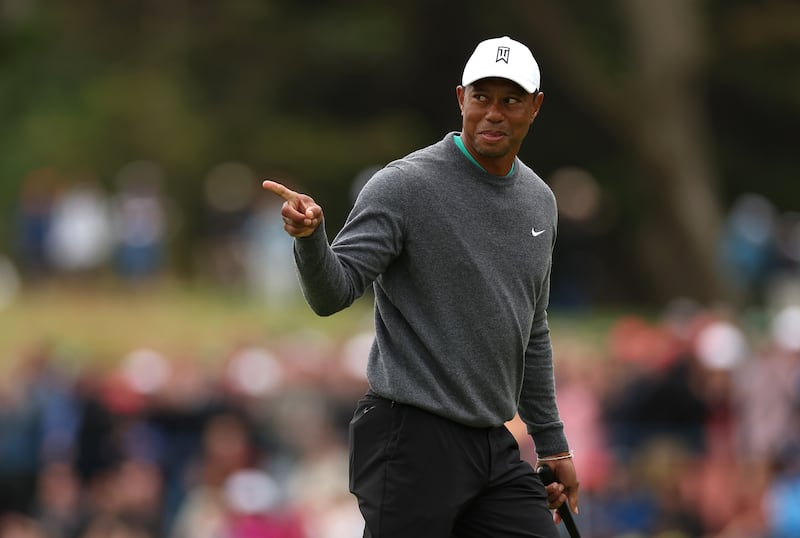It was always about what he did as opposed to what he said. The rise of Tiger Woods, to not only the dominant figure in golf but one of the most recognisable individuals in the world, occurred because of what transpired with clubs in hand rather than in front of microphones. The young Woods had a distrust of the press. Relations grew even more complex after scandal hit the golfer’s personal life. The media had to exist alongside him – to an extent careers depended on his prominence – without any sense of mutual warmth until the closing phase of his playing days became a stark reality.
This time, it is absolutely about what he says. Woods will make another comeback – Sinatra, etc – at next week’s Hero World Challenge in the Bahamas. With his foundation a benefactor and the backdrop lacking frenzy, Woods has made a habit of Albany appearances in December. This will be his first since he limped out of the Masters. Participation is a surprise, given the extent of his physical trouble at Augusta National in April.
During the intervening period, the 47-year-old has marched straight to the centre of golf’s civil war. Rory McIlroy may have departed the PGA Tour’s board scene but Woods, who was appointed in August, remains at the table. He does so as the PGA Tour flutters eyelids at corporate America. Tiger Woods holds considerable appeal for any business seeking investment.
Woods has never appeared to have much time for Greg Norman. The 15-time major winner has been publicly and continually dismissive of the LIV Golf model Norman fronts. When seven-figure appearance fees were being thrown around for participation in LIV’s precursor, the Saudi Invitational, Woods had no interest in playing a part in the kingdom’s none-too-subtle manoeuvres into golf.
READ MORE
So where on earth does this leave Woods as the PGA Tour tries to close out what appears to be an increasingly flaky deal with Saudi Arabia’s Public Investment Fund? He did not leap into an administrative and decision-making position because he had little else to do. This was about exerting influence; and plenty of it. Jay Monahan may be the Tour’s commissioner but Woods is the man players and spectators will follow.
If he chooses to take a public wrecking ball to the PIF alliance when he speaks on Tuesday, the Tour finds itself back in direct opposition to LIV and this sport’s disruption model. The Tour, largely via poster boy Woods, also needs a workable Plan B. Woods may well cite confidentiality clauses but he has a duty to explain what he thinks the direction of travel for the elite game should be for the next several decades. If that is alongside the Saudi investors, Woods will have seriously changed his approach.

Professional golf is not in a pretty place. A looming, December 31st deadline for the PGA Tour, DP World Tour and PIF to produce something beyond a framework agreement looks fanciful. McIlroy was well within his rights to cite time constraints when exiting the boardroom yet it was easy to assume he may not be in full agreement with what is transpiring behind closed doors.
Too many within the sport seem desperate to ensure Saudi riches come to them rather than be distributed elsewhere, therefore completely ignoring the source of these funds. This can be called Newcastle United syndrome. The sight of Martin Slumbers, the normally risk-averse chief executive of the R&A, playing golf alongside the governor of PIF at the Dunhill Links Championship was particularly alarming in this context. The R&A should be above trying to legitimise sportswashing by way of cosy photo opportunities.
Those within LIV continue to talk with absolute certainty about the future; this despite the tour’s lack of broad visibility, sponsorship and traction. The release of a 2024 schedule in recent days came after mumbling from a marquee player, Brooks Koepka, and with now typical gaps. There are loss leaders and there is cold analysis of what PIF must be spending to keep this operation afloat. On basis of calendar space alone, a golf world where traditional tours coexist with LIV makes no more sense now than it did when they announced peace in our golfing time in June.
The PGA Tour could take a punt. It could bank on LIV withering on the vine should a deal be done, instead, with one of the umpteen US private equity ventures which have been sniffing around the sport. LIV could treble down, try to coax more of the world’s top golfers and open warfare – minus legal jousts, which have been permanently halted – would resume. With Woods at the forefront of a recast PGA Tour, it is tough to see it failing.
A snapshot of Woods’s lingering commercial value to the Tour comes by way of its Player Impact Program. The scheme, designed to reward those who bring eyeballs to the product, paid Woods $12 million this year as he finished second to McIlroy (who made $15 million). Woods’s total income from this project has been $35 million over three years in which he has barely struck a ball in anger.
Nate Lashley, the world No 190, called the program a “kick in the teeth” to the rank and file of the Tour. Lashley’s point is undermined by the fact nobody besides dedicated golf followers could pick him out of a lineup. He earned close to $2 million in 2023 thanks to three top-10 finishes in a competition where dollar signs are driven by the big two. Of them, Woods retains the biggest profile. How he chooses to use it in the coming days will prove fascinating. Words, not actions. - Guardian












